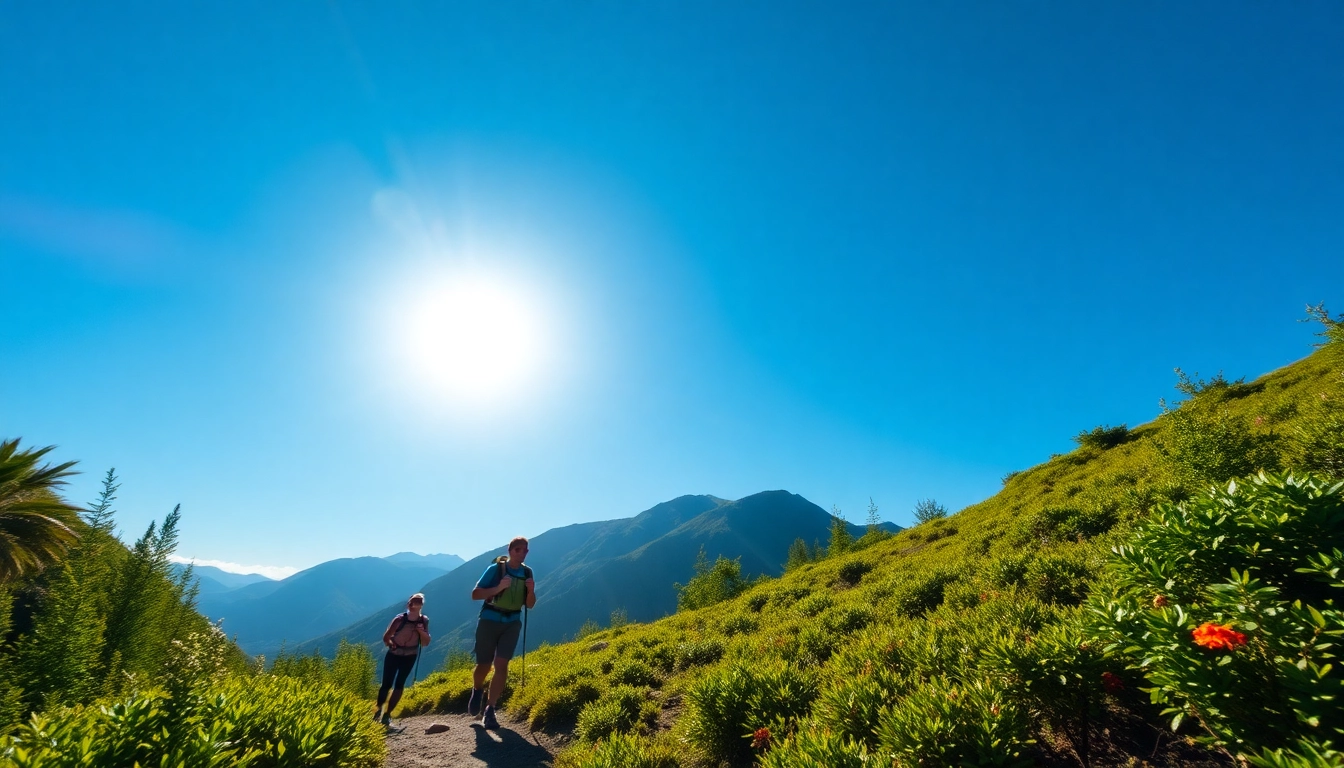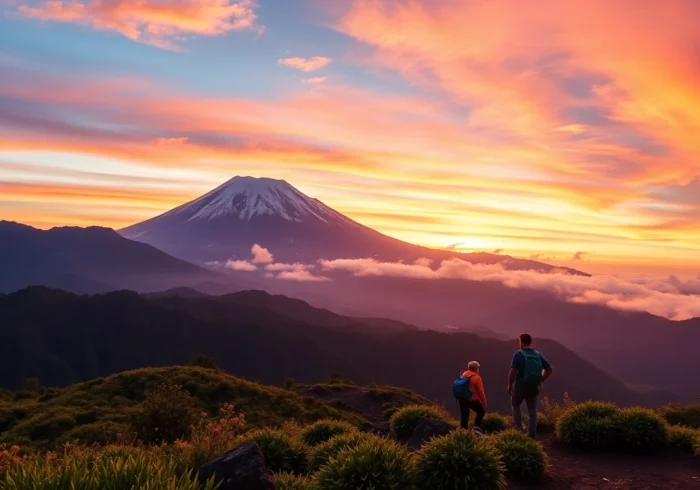Introduction to Hiking in Indonesia: Nature, Culture, and Adventure
Indonesia is a vast archipelago renowned for its incredible natural diversity, rich cultural history, and adventurous outdoor activities. Among the most popular pursuits is hiking, which offers travelers and outdoor enthusiasts a unique opportunity to explore the country’s breathtaking landscapes, from active volcanoes to lush jungles and pristine coastlines. Whether you’re a seasoned trekker or a novice explorer, hiking in Indonesia promises an unforgettable experience that combines physical challenge, cultural immersion, and connection with nature.
This comprehensive guide aims to equip you with crucial insights into hiking—its definitions, significance, safety practices, top destinations, techniques, and health benefits—specifically tailored to Indonesia’s diverse terrains. Understanding the nuances of hiking, alongside meticulous planning and preparation, will ensure your adventures are both enjoyable and safe. Furthermore, by exploring Indonesia’s renowned trails, you will gain an appreciation for how this activity continues to weave into the cultural fabric and local livelihoods of Indonesian communities.
Understanding Hiking: Definitions and Variations
Hiking, at its core, is a recreational activity involving long-distance walking on trails or footpaths in natural environments. It is distinguished from simple walking by its emphasis on traversing varied terrains, often with the goal of experiencing scenic views, physical challenge, or cultural encounters. According to Wikipedia, a hike is typically a vigorous walk in the countryside, often requiring discretionary equipment such as hiking boots or backpacks.
There are several variations of hiking, each suited to different skill levels, interests, and terrains:
- Day Hiking: Shorter hikes that can be completed within a day, perfect for beginners or those with limited time. These often take place in national parks or established trails.
- Backpacking: Multi-day treks that involve camping overnight, requiring more equipment and planning.
- Trail Hiking: Focused on well-maintained paths, often within protected park areas.
- Mountain Hiking: Traversing mountain ranges, including challenging ascents and descents, common in Indonesia’s volcanic landscapes.
- Urban Hiking: Exploring city parks or urban trails, blending city life with nature experiences.
The activity’s variations reflect its versatility, accommodating casual outdoor walks to rigorous expeditions, which is why hiking remains one of the most accessible yet challenging outdoor pursuits worldwide.
For a broader perspective, you can consult resources such as the Wikipedia entry on hiking, which details its history, types, and global relevance.
Why Hiking is a Popular Outdoor Activity in Indonesia
Indonesia’s rugged topography and abundant natural features make it a premier destination for hiking enthusiasts. The activity’s popularity stems from multiple factors:
- Natural Diversity: The country boasts over 170 active volcanoes, dense rainforests, sprawling highlands, and idyllic coastlines, providing an array of trail options.
- Cultural Heritage: Many hikes pass through traditional villages and cultural sites, offering immersive experiential learning.
- Accessibility: Multiple trails are well-established and accessible for various skill levels, from casual walks in Bali’s rice terraces to strenuous climbs in Sumatra’s mountains.
- Adventure Tourism Growth: The government and local communities actively promote adventure travel, including hiking, to boost tourism incomes.
Additionally, the rising awareness about health benefits, eco-tourism, and the desire to escape urban stress contribute to hiking’s surge in popularity. As Indonesia preserves its natural beauty, hiking not only becomes an activity for personal wellness but also a vehicle for environmental conservation and sustainable tourism.
To explore more about outdoor activities in Indonesia and how they intertwine with local lifestyles, visit Lombok Indonesia’s outdoor adventure scene.
Historical and Cultural Significance of Hiking in Local Communities
Long before modern tourism, hiking played an integral role in Indonesian communities. Traditional mountaineer and traveler practices linked the countryside, spiritual sites, and cultural ceremonies. For example, in Bali, trekking up sacred mountains like Mount Agung or Mount Batur was intertwined with religious rituals symbolizing spiritual cleansing and offerings to deities.
Indigenous tribes and local villages often relied on trails for trade, kinship visits, and resource gathering. These paths evolved into formal hiking routes that today attract international visitors seeking authentic cultural experiences. Moreover, community-led conservation efforts ensure that hiking preserves local traditions and promotes sustainable development.
Modern initiatives have recognized hiking as a means to empower indigenous and rural communities. By developing eco-friendly trails and promoting cultural tourism, Indonesia fosters economic growth while respecting ancestral heritage. This synergy between tradition and outdoor activity enhances the authenticity of hikes, making every journey meaningful.
Preserving these cultural ties ensures that future generations will continue to treasure and honor the historical importance of hiking in Indonesia’s social fabric.
Planning Your Hiking Journey: Preparation and Safety Tips
Choosing the Right Trails and Difficulty Levels
Selecting suitable trails is fundamental to an enjoyable and safe hiking experience. Indonesia offers a wide spectrum of options, from beginner-friendly walks to technical mountain climbs. Assess your fitness level, experience, and interests when choosing a trail. For instance:
- Beginner Trails: Easy walks through Bali’s rice terraces or coastal paths in Lombok.
- Intermediate Trails: Moderate hikes around Mount Bromo or exploring lush jungles in Sumatra.
- Advanced Trails: High-altitude ascents on Rinjani or trekking through remote Papuan mountain ranges.
Consult local guides or official trail maps to gauge difficulty levels. Remember, overestimating your ability can lead to hazards, so start with manageable routes and progress gradually.
Essential Hiking Gear and Equipment for Indonesian Terrains
Proper gear significantly improves safety and comfort in Indonesia’s diverse terrains. Key equipment includes:
- Footwear: Durable, waterproof hiking boots with ankle support for volcanic and jungle terrains.
- Clothing: Moisture-wicking layers, rain jackets, hats, and sunglasses to adapt to tropical conditions.
- Navigation Tools: Compass, GPS device, or trail maps. Smartphones with offline maps are also handy.
- Safety Equipment: First aid kit, multi-tool, headlamp, and whistle.
- Camping Gear: Tent, sleeping bag, and stove for multi-day treks.
Investing in quality gear suited for Indonesia’s humid, volcanic, and jungle environments enhances your experience while ensuring safety.
Safety Best Practices and Emergency Preparedness
Safety must be a priority on every hike. Some essential practices include:
- Pre-Hike Planning: Study weather forecasts, trail conditions, and communicate your itinerary to someone trusted.
- Hydration and Nutrition: Carry enough water and high-energy snacks. Water purification tablets or filters are recommended for sourcing from natural streams.
- Environmental Awareness: Respect wildlife and plant life. Avoid disturbing ecosystems and follow Leave No Trace principles.
- Emergency Response: Know basic first aid, carry emergency contact info, and be prepared for unexpected weather changes or accidents.
Joining guided tours or hiring local experts can greatly reduce risks, especially in remote or challenging terrains.
Top Hiking Destinations in Indonesia
Volcano Trails: Rinjani, Kerinci, and Bromo
Indonesia is famously volcanic, and hiking these active and dormant volcanoes offers spectacular scenery and challenging adventures:
- Mount Rinjani (Lombok): Indonesia’s second-highest volcano, featuring a crater lake, hot springs, and panoramic views. Multi-day treks usually take 2–3 days, suitable for experienced hikers.
- Mount Kerinci (Sumatra): The highest volcano in Indonesia, with lush rainforests and diverse wildlife. The ascent involves jungle trekking and a summit view over the surrounding highlands.
- Mount Bromo (East Java): Known for its surreal sunrise and volcanic landscape. Easier to access, ideal for beginners wanting a volcanic experience.
Jungle and Mountain Hikes in Sumatra and Papua
Sumatra and Papua are off-the-beaten-path destinations offering wilderness adventures:
- Gunung Leuser National Park: Trek through tropical rainforests, searching for Sumatran orangutans and exotic flora.
- Papua’s Carstensz Pyramid: The highest peak in Oceania, requiring technical mountaineering skills but offering unrivaled vistas and cultural richness.
Scenic Coastal and Cultural Hiking Routes in Bali and Lombok
These islands combine natural beauty with cultural heritage:
- Mount Agung (Bali): The island’s highest peak, considered sacred, with challenging routes rewarding trekkers with sunset views.
- Selong Belok Beach (Lombok): Coastal hikes along pristine beaches and traditional Sasak villages, perfect for combining nature and cultural immersion.
Hiking Techniques and Experience Enhancement
Navigation Skills and Trail Markings
Mastering navigation ensures safe traversal, especially in remote Indonesian terrains where trail markings may be sparse. Techniques include:
- Understanding topographical maps and compass use to orient yourself.
- Using GPS devices or smartphone apps with offline maps—ensure your devices are charged and protected from humidity.
- Recognizing natural trail markers such as distinctive trees, rocks, or cultural symbols.
Fitness Tips for Different Skill Levels
Building physical resilience is crucial. Recommendations include:
- Beginners: Incorporate regular brisk walking, stair climbing, and core exercises in your routine.
- Intermediate and Advanced Hikers: Engage in endurance training, hill climbing, and strengthening exercises to prepare for steep, prolonged ascents.
- Flexibility and stretching minimize injury risk and improve trail performance.
Eco-friendly Hiking: Leave No Trace Principles
Sustainable hiking preserves Indonesia’s natural beauty for future generations. Key principles encompass:
- Pack out all trash and avoid leaving any waste behind.
- Respect wildlife and avoid disturbing ecosystems.
- Stay on designated trails to prevent erosion and habitat damage.
- Use biodegradable products and minimize campfire impact.
Health Benefits and Personal Growth Through Hiking
Physical Benefits: Endurance, Strength, and Flexibility
Hiking is an excellent cardiovascular workout that enhances muscular strength, flexibility, and endurance. Regular hikes can:
- Improve heart health by engaging large muscle groups.
- Assist in weight management and metabolic health.
- Strengthen leg muscles, core, and stabilizers vital for balance.
Mental and Emotional Wellness from Nature Encounters
Immersing oneself in Indonesia’s natural landscapes has profound mental health benefits. Scientific studies associate wilderness exposure with reduced stress, anxiety, and depression. The rhythmic activity of walking coupled with serene surroundings fosters mindfulness and emotional resilience.
Community and Social Aspects of Group Hiking
Hiking in groups fosters social bonds, cultural exchange, and shared achievement. Many Indonesian communities organize group hikes to promote local tourism and environmental stewardship, enhancing personal growth and collective well-being.

